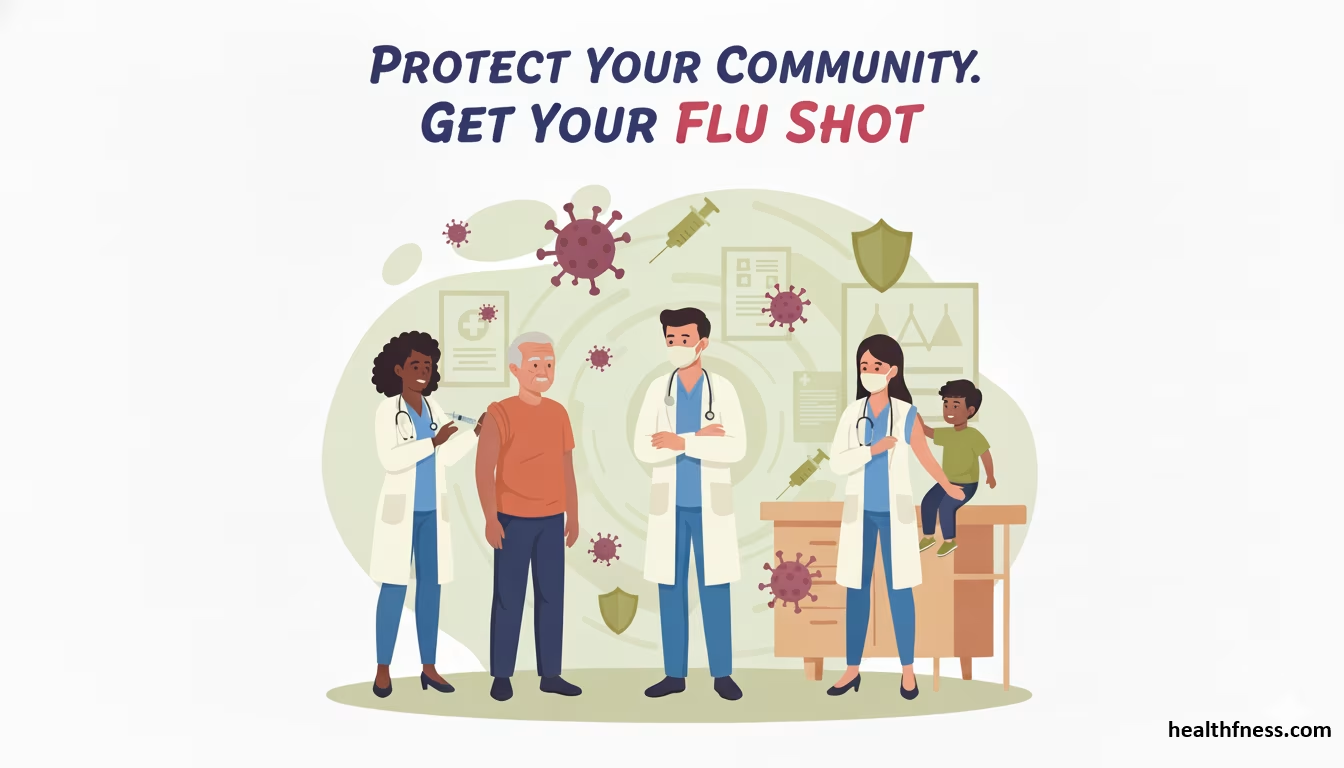Welcome to The Ultimate Flu Shot And Vaccine Guide, your go-to source for comprehensive information about influenza vaccines in the United States for the 2025–2026 flu season. This guide thoroughly explains flu basics, vaccine types, efficacy, safety, public health recommendations, special considerations, and academic insights, tailored for the general public, healthcare professionals, and researchers alike.
Understanding Influenza and Why the Flu Shot Matters
Influenza is a contagious respiratory illness caused by influenza viruses that affect millions annually in the U.S., leading to significant morbidity and mortality. The flu virus spreads primarily through droplets when people cough, sneeze, or talk, making it highly transmittable in communities. Symptoms may vary from mild cold-like signs to severe complications such as pneumonia, exacerbation of chronic conditions, hospitalization, and sometimes death. According to public health data, flu results in tens of thousands of deaths in the U.S. annually, disproportionately affecting vulnerable groups like young children, older adults, pregnant people, and immunocompromised individuals.
Vaccination is the cornerstone of flu prevention, significantly reducing the risk of influenza infection and its serious complications. The flu vaccine stimulates the immune system to produce antibodies targeting viral proteins, providing protection if exposed to circulating influenza viruses. It also helps create herd immunity, protecting those who cannot be vaccinated or who respond poorly to vaccination. No other preventive measure matches the flu shot’s efficacy and safety profile in controlling seasonal influenza.
A Brief History: Evolution of the Flu Shot in the U.S.
Influenza vaccination programs in the United States began in the 1940s with the development of the first inactivated influenza vaccines following World War II. These early vaccines protected against a single virus strain (monovalent). Research and surveillance over decades led to the evolution of multivalent vaccines—covering multiple influenza strains simultaneously to match circulating viruses, initially trivalent formulations, and later quadrivalent.
Technological advances introduced cell-based and recombinant vaccines, reducing reliance on egg cultivation, which prevailed since the origins of vaccine production. High-dose vaccines targeting immune senescence in seniors and adjuvanted formulations for boosting immune response were also developed to address special populations.
Today, the vaccination strategy involves annual review and update by scientific bodies like the CDC, FDA, and WHO, with tailored recommendations for individual and public protection—a testament to decades of scientific progress underscored by rigorous global and local surveillance networks.
How Flu Vaccines Work: Immunology and Protection Mechanism
Influenza vaccines work by exposing the immune system to specific viral antigens—primarily hemagglutinin (HA) and neuraminidase (NA)—allowing the body to recognize and mount rapid defense upon real virus exposure. Upon vaccination, it takes approximately two weeks for the host to develop sufficient antibodies for protection.
The protection is primarily antibody-mediated (humoral immunity) but also involves cell-mediated immunity that controls viral replication and reduces disease severity. Flu vaccines do not contain live, infectious virus (except for nasal spray vaccines, which contain attenuated weakened strains) and cannot cause influenza illness.
Flu Vaccine Types and Strain Composition for 2025–2026
The 2025–2026 U.S. flu vaccines are trivalent, designed to protect against three influenza virus strains expected to predominate during the season:
- Influenza A(H1N1)pdm09-like strain
- Influenza A(H3N2)-like strain
- Influenza B/Victoria lineage strain
Vaccine manufacturers produce several formulations, each suited to different age groups, health statuses, and preferences, including egg-based, cell-based, recombinant, high-dose, and adjuvanted vaccines. Recommendations carefully balance effectiveness, safety, allergies, and immunologic considerations.
| Vaccine Brand | Type | Route of Administration | Age Indications | Preservative Status | Manufacturer | Highlights |
|---|---|---|---|---|---|---|
| Fluarix, FluLaval, Fluzone, Afluria, Flucelvax | Inactivated Influenza Vaccine (IIV3) | Injection | 6 months and older | Most single-dose are preservative-free | GSK, Sanofi, Seqirus | Standard vaccines for most individuals |
| Fluzone High-Dose, Fluad | High-Dose/Adjuvanted IIV3 | Injection | 65 years and older | Preservative-free | Sanofi, Seqirus | Enhanced immune response for older adults |
| Flublok | Recombinant Influenza Vaccine (RIV3) | Injection | 9 years and older | Egg protein and preservative-free | Sanofi | Ideal for egg allergies or egg-free preference |
| FluMist | Live Attenuated Influenza Vaccine (LAIV3) | Nasal spray | 2 through 49 years, healthy individuals only | Preservative-free | AstraZeneca | Needle-free option, contraindicated in pregnancy and immunocompromised |
Who Should Get Vaccinated? Official Recommendations
Universal influenza vaccination is recommended annually for everyone aged 6 months and above who do not have specific contraindications, emphasizing protection of vulnerable groups.
- Children younger than 5 years, especially under 2 years old
- Adults aged 65 years and older
- Pregnant people at any trimester
- People with chronic medical conditions (e.g., asthma, diabetes, heart disease)
- Residents of nursing homes and long-term care facilities
- Healthcare workers and caregivers
- Immunocompromised individuals (with special vaccine considerations)
Timely vaccination—ideally by late October—is important, though vaccination throughout the flu season remains beneficial. Special populations may follow unique vaccine schedules or formulations to optimize protection.
Vaccine Effectiveness and Population-Level Impact
Vaccine effectiveness (VE) varies with strain match, virus evolution, host factors, and vaccine type but generally ranges from 40% to 60% in preventing clinical illness annually. Notably, vaccination significantly reduces hospitalizations, complications, and deaths, especially among seniors and high-risk individuals. Even in mismatched seasons, benefits remain substantial.
Large-scale observational studies and meta-analyses from the U.S. and internationally confirm millions of prevented illnesses and thousands of saved lives each flu season, highlighting the flu shot’s profound population health impact.
Safety Profile and Side Effects
Influenza vaccines administered in the U.S. are subject to rigorous approval processes and safety surveillance. The most common side effects are temporary, mild, and include soreness at the injection site, low-grade fever, malaise, and occasional nasal congestion with nasal sprays.
Serious adverse events, including anaphylaxis, Guillain-Barre Syndrome, or other rare neurological reactions, are extremely uncommon and continuously monitored via the Vaccine Adverse Event Reporting System (VAERS) and other safety programs.
Special Considerations in Diverse Populations
Children
Children aged 6 months through 8 years receiving their first-ever flu shot need two doses spaced at least four weeks apart to ensure adequate immunity. Subsequent seasons typically require only one annual dose.
Seniors
Older adults experience decreased immune responsiveness; thus, high-dose and adjuvanted vaccines are advised to elicit stronger immunity and reduce severe outcomes.
Pregnant People
Pregnant individuals should receive inactivated flu vaccines during any trimester to protect both mother and infant, reducing prematurity, hospitalization, and neonatal flu risk.
Immunocompromised
Immunocompromised persons should receive inactivated or recombinant vaccines instead of live attenuated forms, with vaccination of close contacts emphasized to create protective cocooning.
Egg Allergy and Other Allergies
Egg protein-free plants-based vaccines are now mainstream, allowing safe vaccination of people with egg allergies. Observational protocols for rare allergy cases are standard to rapidly identify and manage reactions.
Access, Distribution, and Cost
Over 150 million flu vaccine doses are projected for the 2025–2026 U.S. season. Vaccines are widely available through healthcare providers, pharmacies, community clinics, workplace programs, and schools. Health insurance plans cover flu shots as preventive care at no cost; federally funded programs like Vaccines For Children (VFC) bridge gaps for uninsured populations.
Efforts to improve equity focus on underserved and racial minorities, rural residents, and immigrant populations, highlighting outreach, education, and innovative service delivery models.
Vaccination Myths Debunked
- The flu shot cannot give you the flu—it contains no live virus capable of causing illness (except weakened viruses in nasal spray, which also cannot cause flu).
- Annual vaccination is essential because flu viruses constantly evolve, and immunity wanes over time.
- Vaccines are safe for pregnant people and protect babies via maternal antibodies.
- Egg allergies are not a contraindication due to egg-free vaccine options.
- No link exists between vaccines and autism or other chronic conditions.
Frequently Asked Questions (FAQs)
- What is the best time to get a flu shot?
- Typically, vaccination should occur by late October, but getting vaccinated later in the season still provides protection.
- Can I get vaccinated if I have a mild illness?
- Yes, mild illness is not a contraindication. Severe illness warrants postponing vaccination until recovery.
- How long does it take for protection to develop?
- Approximately two weeks after vaccination, sufficient protective antibodies develop.
- What if I miss the second dose for my child?
- The second dose should be administered as soon as possible; restarting the series is not necessary.
- Are there any risks associated with flu vaccination?
- Serious adverse effects are rare. Common side effects are mild and temporary.
Using This Guide for Academic and Clinical Purposes
This guide synthesizes authoritative sources relevant for public health professionals, clinicians, and researchers. For academic citations, reference primary sources including the CDC, FDA, WHO, and peer-reviewed journals like JAMA, NEJM, and CDC’s Morbidity and Mortality Weekly Report.
Research on flu vaccine epidemiology, immunology, and policy highlights ongoing developments in vaccine technology, strain surveillance, and vaccination strategies, underpinning recommendations issued annually.
References

Dr. Mark Jenkins, MD - General Physician (California, USA)
Dr. Mark Jenkins is a board-certified general physician based in the United States, specializing in preventive medicine, nutrition, and lifestyle health. With years of clinical experience in primary care, he is dedicated to helping patients and readers alike make informed, science-based decisions about their well-being.
As a trusted medical reviewer and contributor to Healthfness.com, Dr. Jenkins ensures that all health content meets the highest standards of accuracy, safety, and evidence-based medicine. His expertise bridges modern medical science with practical, everyday wellness strategies, making complex topics approachable for all audiences.
Outside the clinic, Dr. Jenkins is passionate about living the healthy lifestyle he teaches. He enjoys hiking with his dog, experimenting with vegetarian cooking, and exploring the latest health research. He believes that small, consistent lifestyle changes lead to lasting health improvements, and he aims to inspire readers to take proactive steps toward a healthier, happier life.
Explore more of Dr. Jenkins’ evidence-based insights at Healthfness.com



